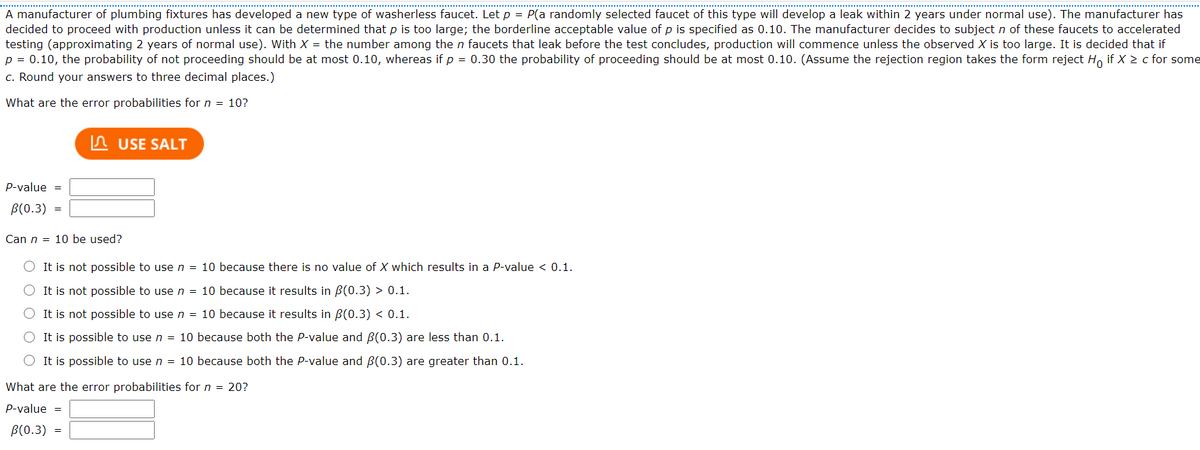A manufacturer of plumbing fixtures has developed a new type of washerless faucet. Let p = P(a randomly selected faucet of this type will develop a leak within 2 years under normal use). The manufacturer has decided to proceed with production unless it can be determined that p is too large; the borderline acceptable value of p is specified as 0.10. The manufacturer decides to subject n of these faucets to accelerated testing (approximating 2 years of normal use). With X = the number among the n faucets that leak before the test concludes, production will commence unless the observed X is too large. It is decided that if p = 0.10, the probability of not proceeding should be at most 0.10, whereas if p = 0.30 the probability c. Round your answers to three decimal places.) proceeding should be most 0.10. (Assume the rejection region takes the form reject H, if X 2 c for so What are the error probabilities for n = 10? I0 USE SALT
A manufacturer of plumbing fixtures has developed a new type of washerless faucet. Let p = P(a randomly selected faucet of this type will develop a leak within 2 years under normal use). The manufacturer has decided to proceed with production unless it can be determined that p is too large; the borderline acceptable value of p is specified as 0.10. The manufacturer decides to subject n of these faucets to accelerated testing (approximating 2 years of normal use). With X = the number among the n faucets that leak before the test concludes, production will commence unless the observed X is too large. It is decided that if p = 0.10, the probability of not proceeding should be at most 0.10, whereas if p = 0.30 the probability c. Round your answers to three decimal places.) proceeding should be most 0.10. (Assume the rejection region takes the form reject H, if X 2 c for so What are the error probabilities for n = 10? I0 USE SALT
MATLAB: An Introduction with Applications
6th Edition
ISBN:9781119256830
Author:Amos Gilat
Publisher:Amos Gilat
Chapter1: Starting With Matlab
Section: Chapter Questions
Problem 1P
Related questions
Topic Video
Question

Transcribed Image Text:A manufacturer of plumbing fixtures has developed a new type of washerless faucet. Let p = P(a randomly selected faucet of this type will develop a leak within 2 years under normal use). The manufacturer has
decided to proceed with production unless it can be determined that p is too large; the borderline acceptable value of p is specified as 0.10. The manufacturer decides to subject n of these faucets to accelerated
testing (approximating 2 years of normal use). With X = the number among the n faucets that leak before the test concludes, production will commence unless the observed X is too large. It is decided that if
p = 0.10, the probability of not proceeding should be at most 0.10, whereas if p = 0.30 the probability of proceeding should be at most 0.10. (Assume the rejection region takes the form reject Ho if X > c for some
c. Round your answers to three decimal places.)
What are the error probabilities for n = 10?
In USE SALT
P-value =
B(0.3) =
Can n = 10 be used?
O It is not possible to usen = 10 because there is no value of X which results in a P-value < 0.1.
O It is not possible to use n = 10 because it results in B(0.3) > 0.1.
O It is not possible to use n = 10 because it results in B(
) < 0.1.
O It is possible to use n = 10 because both the P-value and B(0.3) are less than 0.1.
O It is possible to use n = 10 because both the P-value and B(0.3) are greater than 0.1.
What are the error probabilities for n = 20?
P-value =
B(0.3)

Transcribed Image Text:What are the error probabilities for n = 25?
P-value
%3D
B(0.3) =
Expert Solution
This question has been solved!
Explore an expertly crafted, step-by-step solution for a thorough understanding of key concepts.
This is a popular solution!
Trending now
This is a popular solution!
Step by step
Solved in 2 steps with 1 images

Knowledge Booster
Learn more about
Need a deep-dive on the concept behind this application? Look no further. Learn more about this topic, statistics and related others by exploring similar questions and additional content below.Recommended textbooks for you

MATLAB: An Introduction with Applications
Statistics
ISBN:
9781119256830
Author:
Amos Gilat
Publisher:
John Wiley & Sons Inc

Probability and Statistics for Engineering and th…
Statistics
ISBN:
9781305251809
Author:
Jay L. Devore
Publisher:
Cengage Learning

Statistics for The Behavioral Sciences (MindTap C…
Statistics
ISBN:
9781305504912
Author:
Frederick J Gravetter, Larry B. Wallnau
Publisher:
Cengage Learning

MATLAB: An Introduction with Applications
Statistics
ISBN:
9781119256830
Author:
Amos Gilat
Publisher:
John Wiley & Sons Inc

Probability and Statistics for Engineering and th…
Statistics
ISBN:
9781305251809
Author:
Jay L. Devore
Publisher:
Cengage Learning

Statistics for The Behavioral Sciences (MindTap C…
Statistics
ISBN:
9781305504912
Author:
Frederick J Gravetter, Larry B. Wallnau
Publisher:
Cengage Learning

Elementary Statistics: Picturing the World (7th E…
Statistics
ISBN:
9780134683416
Author:
Ron Larson, Betsy Farber
Publisher:
PEARSON

The Basic Practice of Statistics
Statistics
ISBN:
9781319042578
Author:
David S. Moore, William I. Notz, Michael A. Fligner
Publisher:
W. H. Freeman

Introduction to the Practice of Statistics
Statistics
ISBN:
9781319013387
Author:
David S. Moore, George P. McCabe, Bruce A. Craig
Publisher:
W. H. Freeman